27 of the Most Colorful Birds in the World
Last Updated on
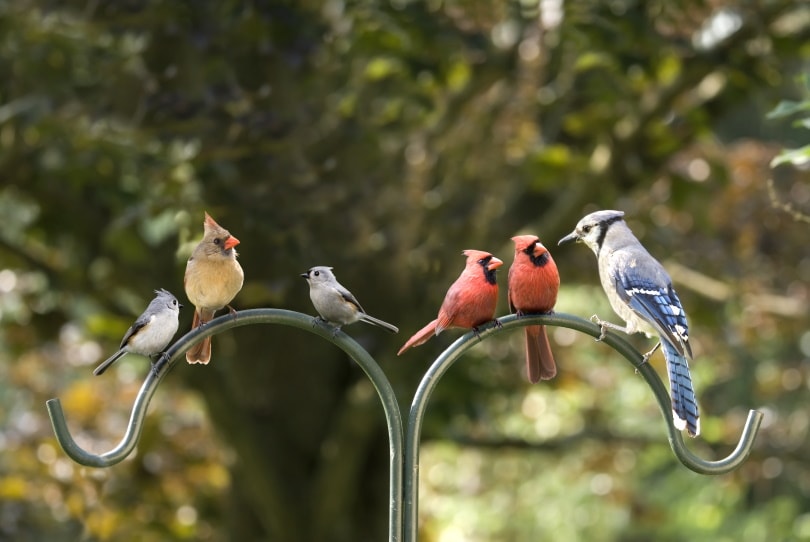

The 27 Most Colorful Birds in the World
1. Nicobar Pigeon

| Scientific Name | Caloenas nicobarica |
| Coloring Features | Shades of green |
| Where They Live | Southeast Asia |
The Nicobar Pigeon is considered to be the closest living relative to the now extinct Dodo Bird. They have beautiful long feathers around their necks that are different shades of green, yellow, and blue. Their bodies are typically dark green or greyish, and their legs have a reddish tone.
2. Wilson’s Bird of Paradise
https://www.instagram.com/p/CN-D660BkdA/
| Scientific Name | Diphyllodes respublica |
| Coloring Features | Bright mantles, crimson wings |
| Where They Live | Indonesia |
These are small birds but they have big colors! The males have bald, blue heads, yellow mantles, wings of crimson, and bluish feet. Their underbellies are typically various shades of green. They sometimes have shades of red around the belly and tail. The females aren’t as vibrant. They have dull brown and reddish colorings.
3. Golden Pheasant

| Scientific Name | Chrysolophus pictus |
| Coloring Features | Gold, orange, red feathers |
| Where They Live | China |
Male Golden Pheasants are brightly colored with red undersides, yellow heads and backs, and golden-colored legs. The females typically only have gold and brown tones. These birds spend most of their time on the ground or in trees rather than flying. Their long tails help them navigate through rough terrains.
4. Red-Necked Tanager
https://www.instagram.com/p/CVnYiVyr7Rn/
| Scientific Name | Tangara cyanocephala |
| Coloring Features | Red necks, green bellies |
| Where They Live | The Neotropics |
As their name suggests, these birds have bright red necks that help them stand out from the crowd. Their bright green underbellies give way to dark grey or blue legs. Their heads are dark blue, and their wings are usually black, orange, and green. They have short tail feathers that match their undersides.
5. Flamingo

| Scientific Name | Phoenicopterus ruber |
| Coloring Features | Bright pink feathering |
| Where They Live | Worldwide |
Although Flamingos are born with soft, white feathers, their feathers gradually get replaced with vibrant, bright pink feathers that are larger in size. Many flamingos do maintain some white feathering that gives them a slightly marbled look. These omnivorous birds stand on long legs that are reminiscent of stilts.
6. Spangled Cotinga
https://www.instagram.com/p/BzK-FHEADDR/
| Scientific Name | Cotinga cayana |
| Coloring Features | Baby blue body feathers |
| Where They Live | The Amazon |
These medium-sized birds have stout, compact bodies and brilliant baby blue feathers on the belly, back, and head. The bottoms of their necks are deep purple and their wings a darker blue with hints of the baby blue mixed in. They have large, round, alert eyes and short pointy beaks.
7. Rainbow Lorikeet
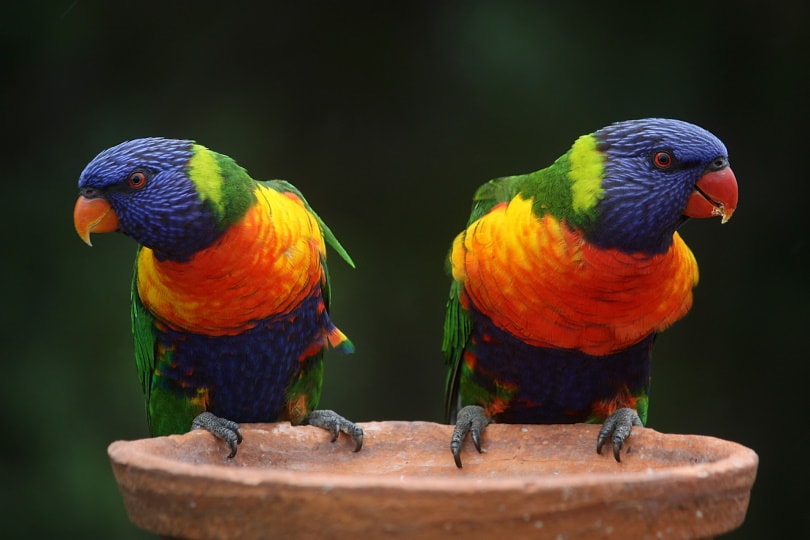
| Scientific Name | Trichoglossus moluccanus |
| Coloring Features | Blue, orange, red, green, yellow feathering |
| Where They Live | Australia |
These lively birds live in the rainforests and coastal areas of Australia. They are easy to spot due to the multiple bright colors on their feathers. Their heads are dark blue and their wings and bodies bright green. Some red, orange, and yellow feathering is almost always present.
8. Mandarin Duck

| Scientific Name | Aix galericulate |
| Coloring Features | Multicolored plumage |
| Where They Live | Asia |
These gorgeous ducks are so colorful and impressive that zoos and individuals keep them in captivity all over the world. Sadly, their numbers are dwindling in the wild. The Mandarin Duck has a wide variety of colors throughout its plumage, including green, blue, orange, red, brown, yellow, and even purple.
9. Resplendent Quetzal
https://www.instagram.com/p/CVzALQmAqlr/
| Scientific Name | Pharomachrus mocinno |
| Coloring Features | Bright green bodies, red undersides |
| Where They Live | Mexico, Panama |
Resplendent Quetzals only grow to be about 16 inches long when they are fully grown. However, their vibrantly colored plumage makes them stand out among the trees and bushes. They have bright green bodies ad even brighter red chests and bellies. When in the sunlight, their green feathers may look like they are brushed with hues of yellow cobalt and aqua colors.
10. Keel-Billed Toucan

| Scientific Name | Ramphastos sulfuratus |
| Coloring Features | Brightly colored bills |
| Where They Live | Mexico, Columbia, Venezuela |
The body of a Keel-Billed Toucan is usually black, but the neck and the bill are interesting. This bird’s neck is typically light yellow. Their bill is usually bright green, red, and orange in color. The tip of the tail has small red feathers, and the feet are medium to dark blue.
11. Scarlet Macaw

| Scientific Name | Ara macao |
| Coloring Features | Scarlet, blue, yellow bodies |
| Where They Live | South America, Central America |
These colorful birds are commonly found in zoos and sanctuaries worldwide. In the wild, they can be found living in South and Central America. The Scarlet Macaw typically has a scarlet red head and yellow and blue feathers throughout its body. The tail feathers are almost always light blue.
12. Western Crowned Pigeon

| Scientific Name | Goura cristata |
| Coloring Features | Vibrant blue plumage |
| Where They Live | Iran, Indonesia, New Guinea |
The crests on these birds are what make them look unique. They look like they are wearing feathery headdresses. Their bodies are greyish blue with black and dark blue markings. Although their feathers are not bright or vibrant, they are unique and gorgeous.
13. Painted Bunting
https://www.instagram.com/p/CCjmfMaJ306/
| Scientific Name | Passerina ciris |
| Coloring Features | Colorful male bodies, green female bodies |
| Where They Live | United States |
These birds resemble the common finch but have different feather and plumage colors. Male Painted Buntings have blue heads, green and red wing feathers, and bright red undersides. The tips of their feathers are usually dark grey or brown. Females have full green bodies with yellow markings on the belly.
14. Lady Gouldian Finch

| Scientific Name | Chloebia gouldiae |
| Coloring Features | Vibrant multicolored bodies |
| Where They Live | Australia |
These birds are extremely vibrant when it comes to color. Their heads are bright red and lime green. Their chests are a vibrant purple color. Their bellies are bright yellow. Their wings are green. Their backends happen to be baby blue. They look like they are covered in some sort of patchwork art that would be shown in a fine museum.
15. Northern Cardinal
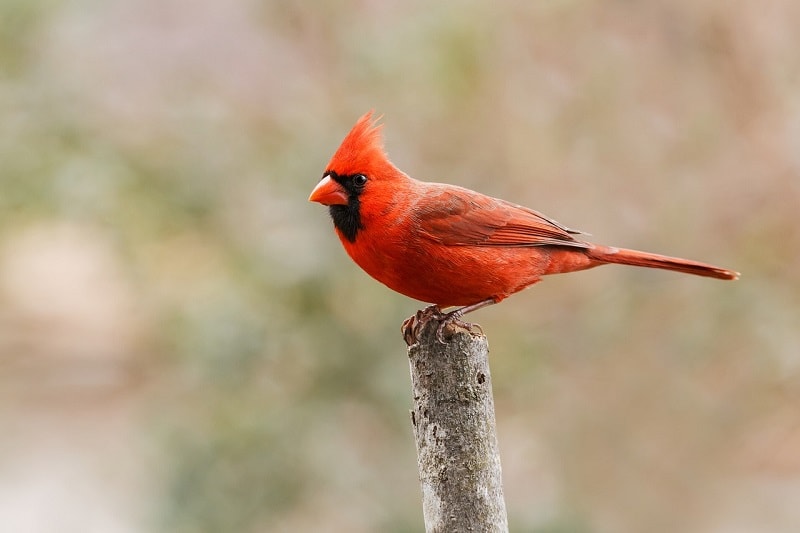
| Scientific Name | Gardinalis cardinalis |
| Coloring Features | Bright red bodies |
| Where They Live | United States, Canada |
These little birds have super-long tails and short, thick bills. The males are bright red with black markings around their eyes and a little black feathering marbled into the red on their wings. The females better blend into the wild with dull green or brown feathers and little red markings throughout the body. They do have bright bills like the males do, though.
16. Common Kingfisher
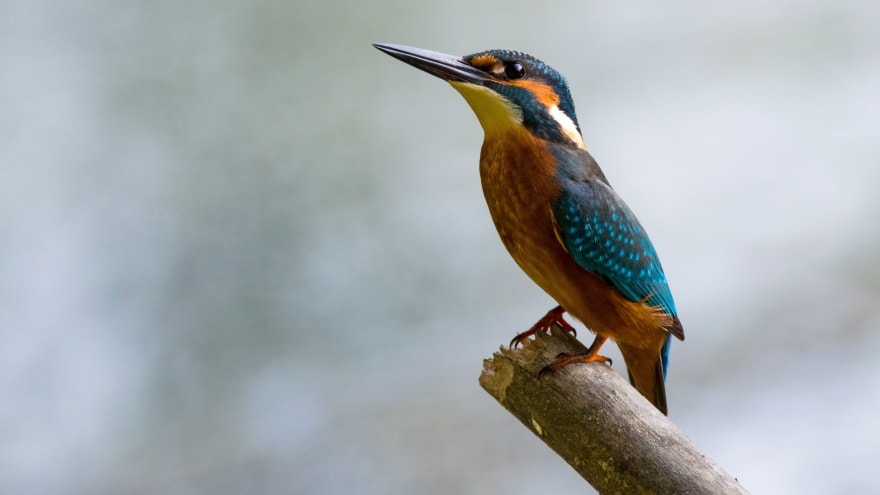
| Scientific Name | Alcedo altthis |
| Coloring Features | Bright blue or emerald-green heads and backs, golden undersides |
| Where They Live | Africa, Asia, Europe |
The Common Kingfisher has an impressively long bill, a short stubby body, and a short, stout tail. Males have bright blue heads and wings with golden bellies. Females also have golden bellies, but they typically have emerald-green heads and backs. Both males and females have white markings along the neck and small white dots on their heads and wings.
17. Indian Peafowl

| Scientific Name | Pavo cristatus |
| Coloring Features | Brightly colored tail feathers |
| Where They Live | Indian subcontinent |
Commonly known as a Peacock, the Indian Peafowl is beautifully colored from head to toe. Their bodies have a gorgeous blue hue and their huge tail feathers have hues of green, aqua, blue, red, yellow, and black. Some have interesting black circle markings that people sometimes compare to eyes.
18. Red-Bearded Bee-Eater
https://www.instagram.com/p/CAeW7LiA1to/
| Scientific Name | Nyctyomis amicus |
| Coloring Features | Green bodies, red faces |
| Where They Live | Worldwide |
These little birds love to spend their time in trees. They are expert branch perchers and singers. They have bold bodies full of green feathers, bright red faces, and extremely long black bills. Their foreheads usually have bright pink markings. Their green tail feathers are long and bushy, giving them a fuller and bigger look.
19. Curl-Crested Aracari

| Scientific Name | Pteroglossus beauharnaisili |
| Coloring Features | Green, red, orange, grey feathering |
| Where They Live | The Amazon |
The huge bills on these birds make them look disproportionate. However, their stocky, colorful bodies set them apart from the crowd. They have bright green markings around their eyes, white specks of color on their heads, dark green wings, red bellies, and back markings, and yellow chest markings.
20. Paradise Tanager
https://www.instagram.com/p/CVdpEMqJ4ka/
| Scientific Name | Tangara chilensis |
| Coloring Features | Bright blue, red, green, and black bodies |
| Where They Live | South America |
This is a startlingly gorgeous bird with unique coloring patterns that won’t be found on other birds. Their base is black, but they have light blue chests and bellies, bright lime-green faces, and huge patches of red on their backs.
21. Splendid Fairywren
https://www.instagram.com/p/CJfuU1mlpzm/
| Scientific Name | Malurus splendens |
| Coloring Features | Dark blue bodies |
| Where They Live | Australia |
This is a small blue bird with a long tail. What makes it stand out are the different hues of blue displayed on the head, back, chest, and wings. Ranging from powder blue to midnight blue, every one of these birds has a unique pattern that cannot be found on other types of birds in the wild.
22. Lilac-Breasted Roller

| Scientific Name | Coracias caudatus |
| Coloring Features | Rusty red necks, aqua green wings |
| Where They Live | Africa |
As their name suggests, Lilac-Breasted Rollers have lilac-red chests that brighten up their whole bodies. Their heads have white markings and their short bills are black. Their wings have aqua blue markings, and the areas right above their tails are usually black.
23. American Purple Gallinule
https://www.instagram.com/p/CKeZHpJgWoW/
| Scientific Name | Porphyrio martinicus |
| Coloring Features | Dark blue heads and chests, green back feathers and wings |
| Where They Live | United States, Caribbean |
This is a medium-sized bird that can grow up to 24 inches in length when fully grown. The American Purple Gallinule’s beak is bright red at the base, and a prominent white mark is seen on their foreheads. Their heads and chests are royal blue, while their backs and wings are a mixture of green, orange, and yellow.
24. Andean Cock-of-the-Rock
https://www.instagram.com/p/CUAlEtRpjs7/
| Scientific Name | Rupicola peruvianus |
| Coloring Features | Bright red tops, dark bottoms |
| Where They Live | The Andes |
These birds are striking in color and design. Their eyes look like they are far back in their heads because of their big lumpy bills. Their heads, necks, and chests are covered in bright red feathers. The bottom half of their bodies are covered in black feathers. They have amazing grey feathers on their back leading down to their tail feathers.
25. Crimson Rosella

| Scientific Name | Platycercus elegans |
| Coloring Features | Red, blue, and brown feathering |
| Where They Live | Australia |
These birds are decorated with red heads and chests, light blue wing and tail feathers, dark blue markings, and black tail ends. Their white bills seem to have been designed in contrast to the rest of their bodies. These birds seem to sing gleefully while living in nature, but they are quite quiet when they are living in captivity.
26. Red-Billed Blue Magpie
https://www.instagram.com/p/B5dmO43ATHG/
| Scientific Name | Urocissa erythroryncha |
| Coloring Features | Black heads, colorful bodies |
| Where They Live | Worldwide |
While not bright in color, these birds display striking grey feathers on their backs and wings. Their extra-long tail feathers are light grey with white tips. Their heads are black, and their bills are bright orange, as are their legs and feet. Some white markings are typically displayed on their back feathers.
27. Blue Jay
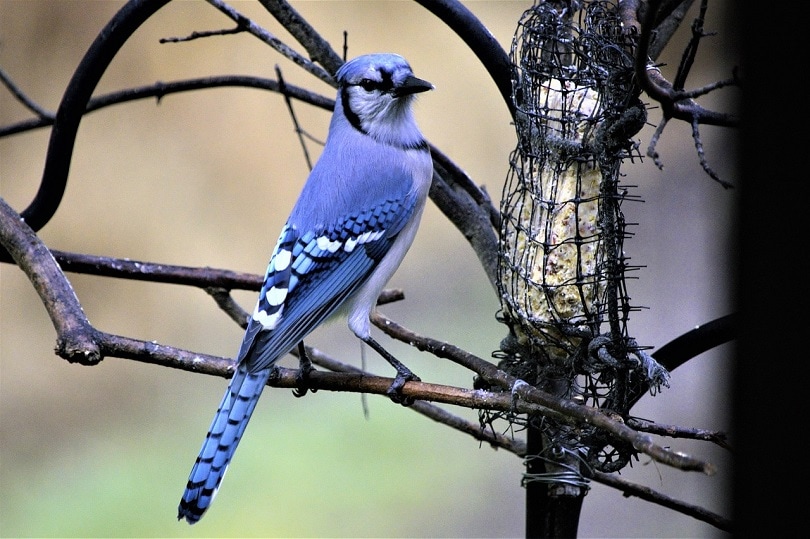
| Scientific Name | Corvidae cristata |
| Coloring Features | White and blue bodies |
| Where They Live | Canada, United States |
This bird’s pronounced crest is its most unique feature. The crest is usually smokey blue, as is the back. These birds have white markings around their eyes, white faces, and white bellies. Their tails are typically aqua blue and black. Their legs are blue too.

Conclusion
There is a multitude of beautiful birds in existence and many that are no longer with us. Every year, a new bird seems to be featured for its gorgeous markings or stout figure. The truth is that all birds are beautiful. Since beauty is in the eye of the beholder, it is never a done deal when creating a list of beautiful birds in the world. The list can always be tweaked and changed as new varieties are discovered!
See also:
Featured Image Credit By: SAJE, Shutterstock
Table of Contents
- The 27 Most Colorful Birds in the World
- 1. Nicobar Pigeon
- 2. Wilson’s Bird of Paradise
- 3. Golden Pheasant
- 4. Red-Necked Tanager
- 5. Flamingo
- 6. Spangled Cotinga
- 7. Rainbow Lorikeet
- 8. Mandarin Duck
- 9. Resplendent Quetzal
- 10. Keel-Billed Toucan
- 11. Scarlet Macaw
- 12. Western Crowned Pigeon
- 13. Painted Bunting
- 14. Lady Gouldian Finch
- 15. Northern Cardinal
- 16. Common Kingfisher
- 17. Indian Peafowl
- 18. Red-Bearded Bee-Eater
- 19. Curl-Crested Aracari
- 20. Paradise Tanager
- 21. Splendid Fairywren
- 22. Lilac-Breasted Roller
- 23. American Purple Gallinule
- 24. Andean Cock-of-the-Rock
- 25. Crimson Rosella
- 26. Red-Billed Blue Magpie
- 27. Blue Jay
- Conclusion
About the Author Rachael Gerkensmeyer
Since 2000, Rachael has been a freelance writer, and has had an opportunity to research and write about many different topics while working to master the art of fusing high-quality content with effective content marketing strategies. She is an artist at heart and loves to read, paint, and make jewelry in her spare time. Rachael is obsessed with helping animals in need both in her community and anywhere in the world where she feels she can make a difference. She lives off the grid in Hawaii with her husband, her garden, and her rescue animals including 5 dogs, a cat, a goat, and dozens of chickens, so it's no surprise that animals happen to be her favorite topic to write about!
Related Articles:
How to Clean a Refractor Telescope: Step-by-Step Guide
How to Clean a Telescope Eyepiece: Step-by-Step Guide
How to Clean a Rifle Scope: 8 Expert Tips
Monocular vs Telescope: Differences Explained (With Pictures)
What Is a Monocular Used For? 8 Common Functions
How to Clean a Telescope Mirror: 8 Expert Tips
Brightfield vs Phase Contrast Microscopy: The Differences Explained
SkyCamHD Drone Review: Pros, Cons, FAQ, & Verdict
